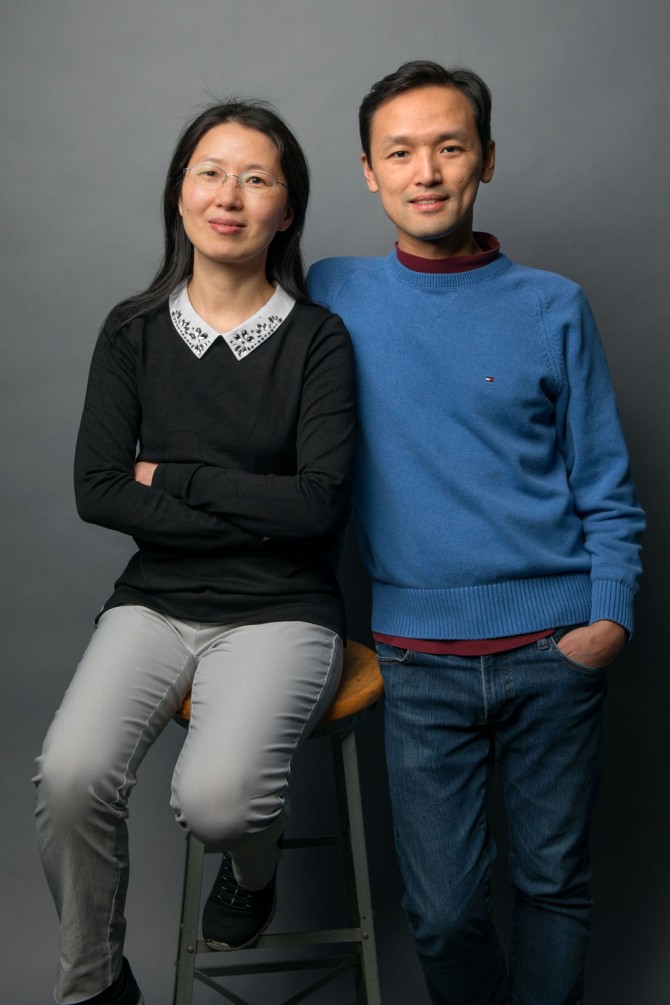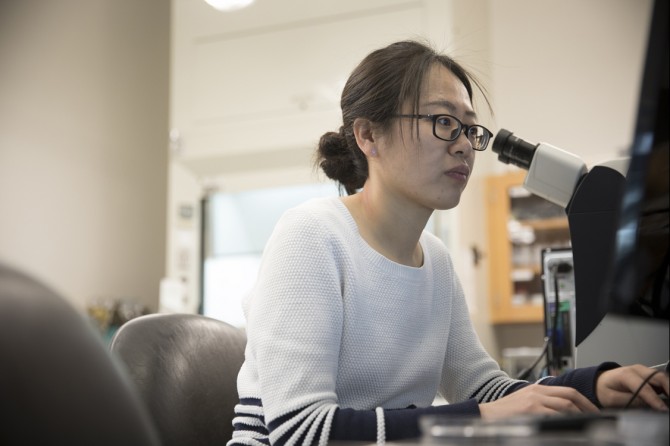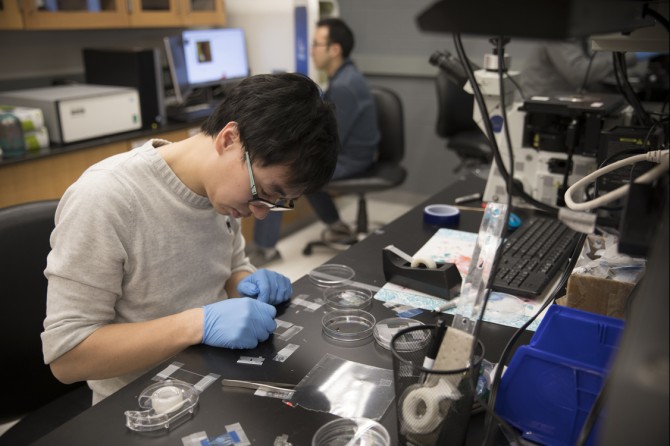
Postdoctoral researcher Shengwei Jiang, front, works in Jie Shan and Kin Fai Mak’s shared lab as Mak observes.
Married physics researchers share lab, students and the joy of discovery
By Joe Wilensky
Jie Shan, professor of applied and engineering physics in the College of Engineering, and Kin Fai Mak, assistant professor of physics in the College of Arts and Sciences, are experts on atomically thin materials, particularly their optical and electronic properties. They also are married and were recruited to Cornell in late 2017 from Penn State through the provost’s Nanoscale Science and Molecular Engineering (NEXT Nano) initiative. They moved their shared lab and joint research group to Ithaca and have been up and running in the Physical Sciences Building since January.
How does your collaboration work, and how did it develop?
Jie Shan: We both have Ph.D.s in physics from Columbia University – we met at Columbia – and our research has since branched out into different directions. So some of our projects have had an engineering flavor, and others more of a physics flavor.
In the late 2000s, this new research direction – two-dimensional materials – has become a focus area.
Kin Fai Mak: Before that, it was more optics-based research, very focused on developing optical spectroscopy techniques and less on the materials side. We combined the two and learned a few new things along the way in order to study two-dimensional materials.
Can you describe your work with these two-dimensional materials?
Shan: These are called two-dimensional, or atomically thin, materials because they are only one, or just a few, atoms thick.
Mak: It’s a very exciting area. It was only about 10 years ago that people really isolated and identified these materials. Before that, it seemed like a crazy, theoretical kind of thing, for instance, to see a single layer of atoms.
Shan: In some old textbooks, people dreamed about what the electronic properties of a single sheet of carbon atoms would be, for example.
Mak: Scientific development is a bit like, if you only have the theory, the theories will run out of ideas quickly. So you need to experiment to stimulate the development of the theory.
Researchers thought single-layer materials would be too hard to see, that they wouldn’t reflect much light. But it turns out that a single layer can reflect almost 100 percent of the light if you do it “correctly,” and so it actually could become too bright to see. There are a lot of interesting optical phenomena happening at this thickness.
These materials have other exciting and counterintuitive properties. They are mechanically very strong. Research has shown that a single layer of carbon atoms is stronger than steel, for example. And they are extremely good conductors – they may be the best conductors – compared to all the other metals.
Shan: This is a new class of materials where you can tailor their properties, because it’s just one sheet, so everything is surface. You can stimulate it, you can do something to it easily. And you can make heterostructures, like a sandwich, putting different things together. You can engineer something that doesn’t exist in nature and with new properties.
What are some real-world applications of your research?
Shan: The field is totally open. We are engineering new properties that could be realized by putting different things together: conductors, insulators, semiconductors. And because it’s just one atom thick, it could lead to making anything flexible you can imagine. Flexible electronics, flexible sensors, transparent electrodes for displays …
Mak: It turns out that a single layer of a carbon atom is so chemically stable that people like to use it for coating, for example, for corrosion protection.
Did you know it would be a good fit when you were both recruited to Cornell?
Mak: I’m not entirely new to Cornell – I was a postdoc at the Kavli Institute at Cornell for Nanoscale Science from 2012 to 2014. And after that, we started our own lab at Penn State. Then the NEXT initiative came along, and we knew Cornell is one of the top places in doing the kind of research we are doing.
Shan: From my visits, I had the impression that people here are very open, it’s very easy to collaborate. The College of Engineering’s applied and engineering physics and the College of Arts and Sciences’ physics department have their labs in the same building, on the same floor.
It’s also to our advantage to have colleagues in two different departments. Now we have two homes, and we look forward to more opportunities to collaborate with colleagues with similar interests.
Mak: One of our biophysics colleagues has her office on the same floor as my office. She is working on optics and we are doing optics, so maybe there is a possibility to collaborate in the future as well.
Shan: Some of the best collaborations are initiated by students. Our students and postdocs have already made friends with students and postdocs in colleagues’ labs, so they already have been talking and trying to work on something together.
Mak: We’re still new here, so we’re still exploring the different possibilities, seeing how we fit in.
What recent technological advances in your research have changed its potential impact?
Shan: Maybe the biggest thing is targeted transfer – being able to transfer different single- or few-layer sheets from one location to another, to stack them, align them or make them the way you want.
Mak: Researchers can now manipulate on a wafer scale a single layer or few layers of atoms in many different materials, not just graphene. If the method could be extended to other more conventionally known ones – like silicon or gallium arsenide – it would have an immediate impact on the semiconductor industry.
What is something that each of you has learned from the other?
Mak: What I’ve learned from Jie is, don’t stop – keep going.
Shan: Yes: for research, one needs to be a long-distance runner.
Mak: That’s what I got inspired by. There are so many different kinds of people, and some are really doing the marathons. Maybe the most famous example of that marathon run is Hans Bethe; he kept making big impacts for 70 years of his career. Almost every decade, new things came out.
Shan: Amazing guy. Every decade, he had some seminal papers.
Mak: So it seems that Jie did not learn anything from me. (laughs)
Shan: (also laughs) That’s not true! I think we are complementary, not just in terms of expertise, but also in terms of personality. Fai is creative, energetic …
Mak: … More spontaneous, less organized, that’s another way to put it.
Shan: I didn’t say that. (laughs)
What excites you most when you look at the future of your fields?
Mak: With these single-layer structures, we are learning more and more about materials with different functionalities – some are magnetic, some are superconducting. With so many different potential combinations of materials, how can we put them together in a way that can create even more exciting properties?
Shan: And there have already been some predictions that when you can do that, new phenomena are expected to emerge.
Mak: And often you get results different from the theory, and it’s a complete surprise.
Shan: As we get to know more about what’s going on in other fields, and with other materials, our hope is that we’ll be able to maybe utilize, introduce these new elements to research collaborations with colleagues.
Mak: We’re just trying different things, exploring the territory, and our hope always is that maybe we can see something really interesting or make a completely new discovery.
Media Contact
Get Cornell news delivered right to your inbox.
Subscribe



